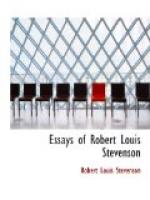[Note 6: The thought of duty. Kant said, “Two things fill the mind with ever new and increasing admiration and awe, the oftener and the more steadily we reflect on them: the starry heavens above and the moral law within.” (Conclusion to the Practical Reason—Kritik der praktischen Vernunft, 1788.)]
[Note 7: Assiniboia ... Calumet. Assinibioia is a district of Canada, just west of Manitoba. Calumet is the pipe of peace, used by North American Indians when solemnizing treaties etc. Its stem is over two feet long, heavily decorated with feathers etc.]
[Note 8: Drowns her child in the sacred river. The sacred river of India is the Ganges; before British control, children were often sacrificed there by drowning to appease the angry divinity.]
[Note 9: The touch of pity. “No beast so fierce but knows some touch of pity.” Richard III, Act I, Sc. 2, vs. 71. This ennobled lemur. A lemur is a nocturnal animal, something like a monkey.]
[Note 10: A new doctrine. Evolution. Darwin’s Origin of Species was published in 1859. Many ardent Christians believe in its general principles to-day; but at first it was bitterly attacked by orthodox and conservative critics. A Princeton professor cried, “Darwinism is Atheism!”]
[Note 11: Cultus. Stevenson liked this word. The swarming ant. “The ants are a people not strong, yet they prepare their meat in the summer.”—Proverbs, XXX. 25. For a wonderful description of an ant battle, see Thoreau’s Walden.]
[Note 12: Everest. Mount Everest in the Himalayas, is the highest mountain in the world, with an altitude of about 29,000 feet.]
[Note 13: The whole creation groaneth. Romans, VIII, 22.]
[Note 14: That double law of the members. See Note 10 of Chapter VI above.]
[Note 15: Den of the vivisectionist. See Note 2 of Chapter VI above.]
[Note 16: In our isle of terror. Cf. Herriet, The White Island.
“In this world, the isle of dreams,
While we sit by sorrow’s streams,
Tears and terrors are our themes.”]
[Note 17: Man that wearies in well-doing. Galatians, VI, 9.]
[Note 18: Surely not all in vain. At heart, Stevenson belongs not to the pessimists nor the skeptics, but to the optimists and the believers. A man may have no formal creed, and yet be a believer.



